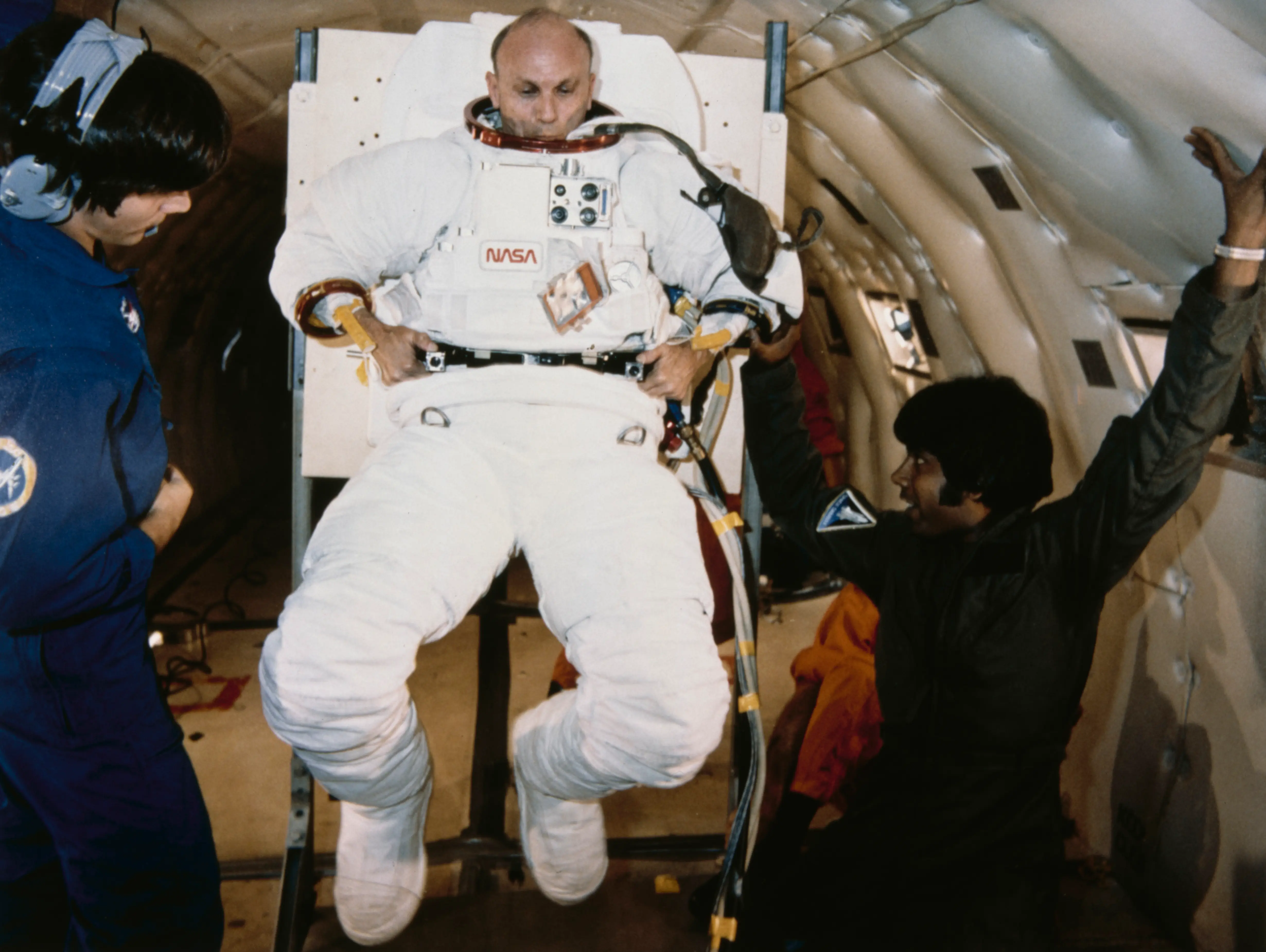The 3I/ATLAS signal has scientists questioning if we’re seeing a rare cosmic event, or the first sign of contact
-
 American astronaut Thomas Kenneth Mattingly II, Commander of the STS-4 NASA Space Shuttle mission on the shuttle Columbia, learns to put on and take off his spacesuit on board a Boeing KC-135 Stratotanker zero-gravity simulator aircraft (known as the 'Vomit Comet'), 22nd July 1981. Mattingly is wearing an extravehicular mobility unit (EMU) minus gloves and helmet. (Photo by Space Frontiers/Archive Photos/Getty Images)
American astronaut Thomas Kenneth Mattingly II, Commander of the STS-4 NASA Space Shuttle mission on the shuttle Columbia, learns to put on and take off his spacesuit on board a Boeing KC-135 Stratotanker zero-gravity simulator aircraft (known as the 'Vomit Comet'), 22nd July 1981. Mattingly is wearing an extravehicular mobility unit (EMU) minus gloves and helmet. (Photo by Space Frontiers/Archive Photos/Getty Images)3I/Atlas just swung past the Sun and set the internet buzzing. The third confirmed interstellar visitor reached perihelion in late October 2025 at roughly 1.3 to 1.4 AU, while observatories watched closely. NASA, ESA, and independent teams saw classic comet behavior from 3I/Atlas with a dusty coma and outgassing as sunlight warmed surface ices.
That is the rare-cosmic-event story that matters to readers today. At the same time, viral posts claim Fibonacci pulses near the hydrogen line and even a decoded phrase. None of that is verified by NASA, SETI, or peer-reviewed work. Harvard astrophysicist Avi Loeb urges open-minded scrutiny of anomalies and has pressed for timely image releases from Mars orbiters.
What is 3I/ATLAS, and why this flyby mattered
3I/Atlas is the third interstellar object confirmed after ʻOumuamua and 2I/Borisov. Discovered by the ATLAS survey on July 1, 2025, it is moving on a hyperbolic path and will not stay in the solar system. Hubble imaged 3I/Atlas on July 21, showing a teardrop-shaped dust cocoon around an icy nucleus. Perihelion occurred around October 30 at about 1.3–1.4 AU, with a safe miss distance from Earth. These numbers place 3I/Atlas in the same broad class as active comets, only with a clear interstellar origin.
Quick numbers for context. Discovery date July 1, 2025. Hubble image date July 21, 2025. Perihelion in late October near 1.3–1.4 AU. Observed coma and outgassing seen before and after perihelion. Minimum Earth distance safely large. That is the baseline against which claims must be weighed for 3I/Atlas.
To set expectations, NASA’s Tom Statler summed up the consensus. As per The Guardian report dated September 11, 2025, NASA planetary scientist Tom Statler said,
“It looks like a comet. It does comet things. It very, very strongly resembles, in just about every way, the comets that we know.”
He stressed that teams would keep collecting data as 3I/Atlas brightened and moved through the inner solar system.
What scientists are actually seeing
Measured signals place 3I/Atlas in familiar territory. Hubble imagery resolved a coma and tail structure. Ground programs tracked the object to refine its hyperbolic orbit. A Swift-based report flagged water-related activity, again consistent with comet processes near the Sun. All of this is the science case for a rare interstellar comet that behaves like an active comet rather than a spacecraft. As per The Guardian report dated October 8, 2025, ESA planetary scientist Michael Küppers stated:
“It looks like a comet and it behaves like a comet. There’s no reason to think it’s something else.”
Institutions have also urged caution. As per the SETI Institute commentary dated October 7, 2025, Nathalie A. Cabrol remarked,
“There are no signs of technology.”
The post adds that astronomers have not detected signals or any sign of propulsion, and it frames 3I/Atlas as a scientifically rich visitor, not a threat. Even the discovery team kept it straight. As per a Reuters report dated August 9, 2025, ATLAS co-principal investigator Larry Denneau said,
“It currently has a faint coma....but the coma and tail may increase dramatically...We don't know what will happen, so that's exciting.”
The point was simple. Early data showed normal cometary activity as teams queued up larger facilities for deeper looks at 3I/Atlas.
The ‘signal’ rumors and the Harvard warning: Claims vs. verification
Rumors about a “signal” from 3I/Atlas centre on two claims. The first is a “Fibonacci” pulse pattern near 1420 MHz, also known as the hydrogen line. The second is a decoded phrase. As per the LondonLovesBusiness report dated October 31, 2025, a story cited social posts that claim a number sequence, a hydrogen-line detection, and the words,
“Observe. Prepare. Understand. The Gate Awaits.”
None of this is confirmed by NASA, SETI, or any instrument team. Harvard’s Avi Loeb has asked agencies to release what Mars-orbiting instruments may have captured when the object passed near the planet on October 3. As per a Medium post dated October 4, 2025, Avi Loeb stated,
“So far, no data from human-made Mars orbiters was publicly released by NASA or ESA.”
His broader stance is to keep an open mind and check anomalies with the best available assets rather than dismissing them outright. That is a testable request that does not validate the “signal” stories on its own. The measured science track, where telescopes continue to report composition, coma evolution, and size constraints, is likely refining how this interstellar comet formed and what it carries.
The verification track where any extraordinary claims must clear a high bar. That means coordinated detections at multiple observatories, instrument metadata, and public archiving that enables independent checks. Until those show up, 3I/Atlas remains a rare interstellar comet with normal comet physics and outsized public attention.
Stay tuned for more updates.
TOPICS: 3I/ATLAS, 3I/ATLAS alien contact, 3I/Atlas nearing sun, Alien invasion, Harvard, NASA
- New images show anti-tail of 3I/ATLAS measured at greater length than Earth-Moon distance
- Viewing 3I/ATLAS up close on December 19 – Which telescopes can help
- IAWN uses interstellar object 3I/ATLAS as a test case for future comet exploration
- Why interstellar comet 3I/ATLAS could reshape what we know about planet formation